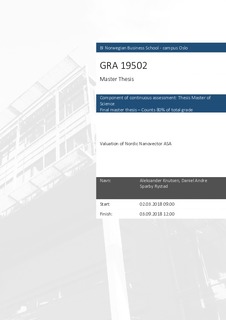Valuation of Nordic Nanovector ASA
Master thesis
Permanent lenke
http://hdl.handle.net/11250/2577008Utgivelsesdato
2018Metadata
Vis full innførselSamlinger
- Master of Science [1621]
Sammendrag
The purpose of this paper is to conduct a valuation of Nordic Nanovector ASA
through the use of both traditional discounted cash flow models and real option
analysis. We have therefore arrived at three different estimates for the company
value. The calculated company values are NOK 6.133.507.000, NOK
3.260.601.301, and NOK 3.946.287.020 generated from the static discounted cash
flow model, expected net present value model, and real options analysis
respectively. Bearing in mind that Nano currently have 49 091 683 shares
outstanding and presupposing the same order as above, we obtain a distribution of
share prices equal to NOK 124.94, NOK 66.42, and NOK 80.39. All these are
larger than the observed prevailing share price for the stock at Oslo stock
exchange, amounting to NOK 50.95 for May 31, 2018.
The paper begins by briefly accounting for our choice of thesis topic and list of
topic questions to be answered. Further information about the company and the
biotech industry is then presented, in order to provide the reader with necessary
insight and some context. Next we give an account of the financial theory
underlying our reasoning and approach throughout the paper, before we proceed
by conducting a strategical analysis for Nano’s attributes. The strategical analysis
is then complemented by an analysis of the historical statements, to create a solid
foundation for the subsequent forecasting of the models important inputs.
Based on the forecasted cash flows and the calculated cost of capital in the
previous step, we are then ready to perform the actual valuation. Two net present
values have been calculated for the project. A static NPV estimate have been
calculated by applying an unadjusted discounted cash flow model, and an
expected NPV estimate have been calculated by probability adjusting the same
DCF model. However, in order to value the inherent flexibility of the project, we
must also apply a real options analysis. The real option analysis follows the
process outlined by Mun (2006), and utilizes the Real Options Super Lattice
Solver software to estimate the total company value of Nano, flexibility included.
The paper ends with a sensitivity analysis aimed at assessing the reasonability of
the generated estimates, a discussion of the papers findings, and ultimately a
conclusions addressing the topic questions
Beskrivelse
Masteroppgave(MSc) in Master of Science in Business, Finance - Handelshøyskolen BI, 2018
